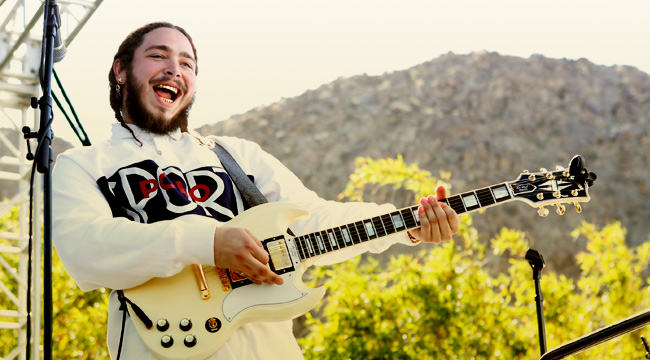
Post Malone has the No. 1 song in the country.
Putting those words together may sound crazy to you. Because once upon a time, Post Malone’s popularity felt accidental. He discussed in interviews how it was a love of Guitar Hero and his dad that propelled him to make music and even labeled himself both a “one-hit wonder” and “industry plant.”
When he appeared on Power 105.1’s The Breakfast Club to promote “White Iverson,” his 2015 breakout hit, Charlamange Tha God grilled him over using the “N-word” in a Vine clip way before “Post Malone” became a thing. That should have been a death blow, but instead, it’s been mostly forgotten. Post Malone has somehow elevated beyond all of the jittery issues that would doom any other artist because he’s likable, talented, and relatable. Those three quantities are the currency in modern day music appeal. At one point in their respective career, every artist wanted to be the dorm room king in regards to music. Post Malone actually grew up and became just that.
“Rockstar,” the 21 Savage collaboration that Post Malone released in mid-September recently became the fifth rap song of 2017 to land at No. 1 on Billboard. It replaced “Bodak Yellow,” Cardi B’s anthemic and self-affirming boast of a debut single. Whereas “Bodak Yellow” picks up energy around the time Cardi tells you about getting her teeth fixed, “Rockstar” hums along, steady the whole way. Despite its paint-by-numbers, “fast life and drugs” zeal, Malone’s yearbook-quote-ready hook and 21 Savage make the track worthwhile.
It’s the type of beat that is tailor-made for 21: Knocky, with enough pop to make his declarations sound bigger than usual, as Savage sarcastically mentions his 12-car garage that only has six cars. 21 makes the song snake in a different direction because it feels less like a Post Malone song and more like a rusty, grave 21 Savage take on nihilism. But, frankly, the two together are what make it sound perfect. And despite breaking all kinds of streaming records on Apple Music, the song registers with a particular crowd as it only sits at No. 20 on the Urban Radio charts. It’s the famous rap song that hasn’t caught on with rap radio but is beloved everywhere else. This suits Post Malone just fine.
https://www.youtube.com/watch?v=_209r9TMB4M
The fascination with Post Malone, “Rockstar” and hip-hop’s insistence on channeling the “live fast, die young” approach of rock music’s glory years prompts some questions. Is Post Malone an actual rapper with discernible technical skill? Not quite. I’d argue, instead, that he falls more into the camp of singer — like Young Thug (minus the revved-up yip of a voice that tries to create a new sound every time out) — and that’s part of what makes him all the more of a perplexing case study.
He’s also not a full-on folk rapper like Everlast was when he struck out by his lonesome to craft Whitey Ford Sings The Blues in 1998. Instead, Post’s in a middle ground of both. His voice can drag certain syllables into joyous, repeatable territory. It’s how certain “pop” sounding records of his like “Too Young” feel like a spill into full-out karaoke. When he wants to wail, he’ll pull out his trusty acoustic guitar and play Nirvana or Green Day to near-perfection. With “Rockstar,” he sings like a drunk college kid on your lawn in the middle of the night. It’s personable and scummy and charming in all the right ways.
So while I wouldn’t consider Post to be a rapper, I also find him to be the kind of artist that could blur all of the lines thanks to how regionless music has become. “White Iverson” was not the greatest signifier that Post Malone would be around for a while. Nor were the songs from his debut album, Stoney, where he sang about drinking codeine out of a broken whiskey glass, a perfect metaphor for his Dallas-metro-meets-Texas-country upbringing.
Rather, Post Malone’s ascent situates itself around one giant collaboration with a talented rapper, (Quavo, on “Congratulations,” the initial hit that blew up to over 400 million Youtube views (“White Iverson”), and a group of fatalist songs such as “Too Young.” Combine all of that and you get an artist that has well over a billion (!) streams and four platinum singles. In a music climate that has found itself championing happy, affable stars, Malone stands as someone who cares nothing for what curmudgeon gatekeepers think of him. As long as he’s making fans happy by creating music they relate to, he can teach them about his idols such as Dylan and Cobain.
As far as rap’s fascination with living a “rockstar” life in 2017? It goes well beyond the idea that rap is the new rock. Rap has been a part of the controversial counterculture for decades now, even as it has also become the sound of the mainstream. With the spread of social media and amplifying attention seekers, it has only made the concept of living like a “rockstar” seem like a normal thing. To be honest, I believe the two concepts have flipped. Rockers don’t want to be rockers anymore; everyone wants to live like rappers. We’re a long way past Nickelback’s take on the idea of what a rock star should be. Instead, we have Post Malone and his idea of a “rockstar”; confidently raging his way past his haters and his limitations with his guitar in tow and a smile on his face.






